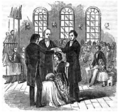Portal:Latter Day Saint movement
|
Welcome to the portal of The Latter Day Saint movement
Introduction The Latter Day Saint movement (also called the LDS movement, LDS restorationist movement, or Smith–Rigdon movement) is the collection of independent church groups that trace their origins to a Christian Restorationist movement founded by Joseph Smith in the late 1820s. Collectively, these churches have over 17 million nominal members, including over 17 million belonging to the Church of Jesus Christ of Latter-day Saints (LDS Church), 250,000 in the Community of Christ, and several other denominations with memberships generally ranging in the thousands of members. The predominant theology of the churches in the movement is Mormonism, which sees itself as restoring again on Earth the early Christian church; an additional doctrine of the church allows for prophets to receive and publish modern-day revelations. A minority of Latter Day Saint adherents, such as members of Community of Christ, have been influenced by Protestant theologies while maintaining certain distinctive beliefs and practices including continuing revelation, an open canon of scripture and building temples. Other groups include the Remnant Church of Jesus Christ of Latter Day Saints, which supports lineal succession of leadership from Smith's descendants, and the more controversial Fundamentalist Church of Jesus Christ of Latter-Day Saints, which defends the practice of polygamy. (Full article...) General images -The following are images from various Latter Day Saint movement-related articles on Wikipedia.
Selected article The denominations in the Latter Day Saint movement are sometimes collectively referred to as Mormonism. Mormon is an informal term used especially when referring to the largest Latter Day Saint denomination, the Church of Jesus Christ of Latter-day Saints (LDS Church), and other offshoots in the movement. Groups opposed to the use of the term Mormon such as the LDS Church consider it to be connected to the polygamy once practiced by the Utah church, or to pejoratives used against early adherents of the movement. The Latter Day Saint movement includes:
Selected location
Selected schismatic historiesThe Church of Christ, informally referred to as the Fettingites, is a denomination within the Latter Day Saint movement which split from the Church of Christ—informally known as "Hedrickites"— in late 1929. The faction was formally established on April 8, 1930, and an Associated Press report published in The New York Times and Los Angeles Times April 7, 1930, describes it as having been briefly named "The Church of Jesus Christ" and later, the "Church of Christ". It is informally referred to as the "Church of Christ (Fettingite)", after its founder, Otto Fetting, but this sect has never officially been named as such. Otto Fetting, an Apostle in the Church of Christ, was the alleged recipient of a series of messages delivered by John the Baptist concerning construction of a temple on the Temple Lot, along with other aspects of Hedrickite doctrine and practice. The rejection of his "Twelfth Message" by a majority vote of his fellow Apostles in October 1929 led to a split in the Temple Lot organization between those who rejected Fetting's messages and those who accepted them. The "Fettingites" subsequently established their own church organization. While Fettingite doctrine and practices are virtually identical to those of the Church of Christ, a significant difference exists today in the acceptance of the messages' authenticity between Hedrickites and Fettingites. The Hedrickite leadership voted at their April, 1936 conference to formally reject Otto Fetting's claim of having heard from John the Baptist, but some laity in the Hedrickite sect have informally expressed interest or belief in his claims, to where about a half-dozen Hedrickites[who?] today believe Fetting received some or all of the revelations he claimed. After its founder's death in 1933, the Fettingite sect further divided into various factions, including The Church of Christ (Restored), the Church of Christ at Halley's Bluff, and the Church of Christ with the Elijah Message. As with the Church of Christ, each of these groups declares itself to be the "only true and living church upon the face of the whole earth." (Full article...)OutlinesRelated portalsKey biographies
Selected image Title page of the original 1830 copy of The Book of Mormon: An Account Written by the Hand of Mormon upon Plates Taken from the Plates of Nephi
Did you know (auto generated)
Selected Anniversaries
Selected quote
TopicsFeatured contentCategoriesWikiProjectsAssociated WikimediaThe following Wikimedia Foundation sister projects provide more on this subject:
Discover Wikipedia using portals | ||||||||||






































